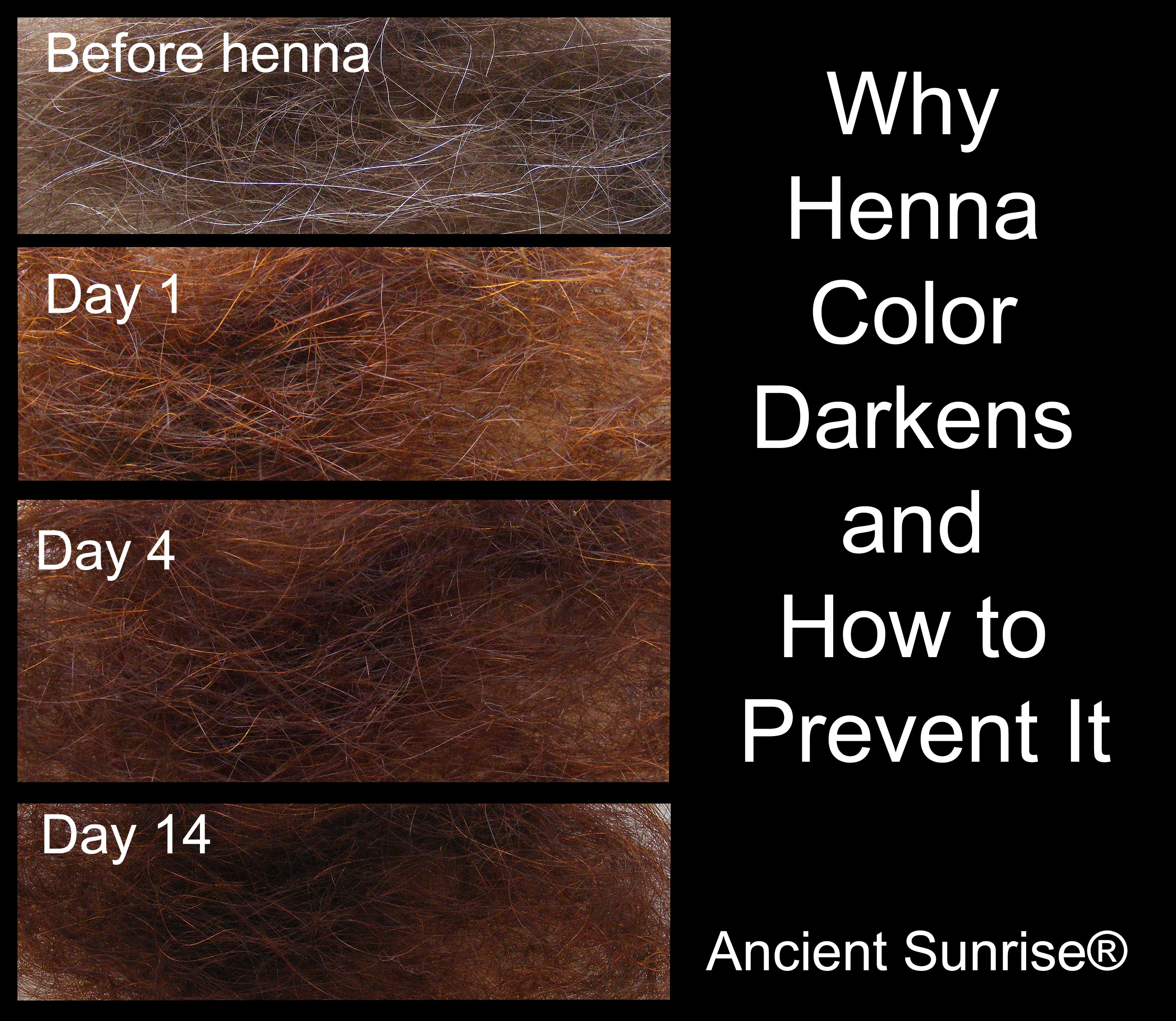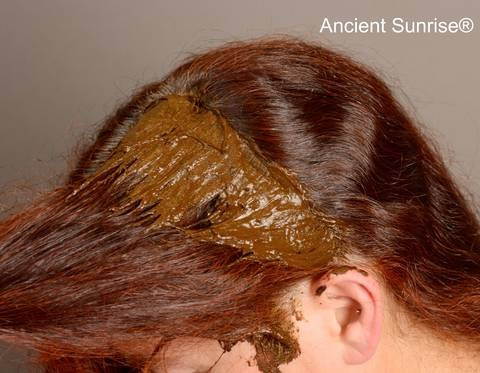
Unlike boxed dyes, henna is permanent and does not fade. With continued applications and exposure to heat or mineral buildup, the color darkens. Henna and indigo also go through oxidation. For those who find their color results too bright, darkening with subsequent applications or heat appliances is a handy technique for adjusting their color. For others who are happy with their color and want to keep it, this can be frustrating. Depending on the cause, you may be able to brighten hennaed hair that has deepened and dulled. In other cases, chemical lightening may be the only option. If you love your result and want to keep it, it is best to be proactive in preventing darkening.
Oxidation
Henna will always oxidize. The most noticeable oxidization happens in the first week after dyeing. The color is bright upon first rinse, and deepens during the subsequent days. Some people get “orange panic” when they first rinse out their henna, as the initial color of a henna application can be a bright copper. This brightness is normal. Within a week, the dye settles in and oxidizes, much like a cut apple exposed to air.

Hennaed hair oxidizes to a deeper shade during the first weeks after application. The majority of noticeable color change occurs in the first two weeks; oxidation continues slowly and minimally thereafter.
In some cases, oxidation can continue and cause the color to darken further. This is common in very acidic mixes. Lemon juice causes a vividly bright copper stain upon first rinse, and that color drops to deep auburn through oxidation. Lemon juice can also be harsh and drying to the hair and scalp. A mix using apple cider vinegar will cause similar issues. If one chooses to use either of these two acidic liquids, diluting with distilled water will lessen undesired brightness, over oxidation, and dryness.
For those who love the bright initial result of a low pH mix, but find lemon juice or AVC too harsh, a good alternative is Ancient Sunrise® Kristalovino fruit acid powder, which gives a similar bright result with less oxidation. Even better is Ancient Sunrise® Copperberry fruit acid powder, which is high in antioxidants, preventing the color from oxidizing over time.
Conversely, those who love the deep auburn color and who find their initial color to be too bright can use Ancient Sunrise® Malluma Kristalovino acid powder, which pushes the overall tone of the henna down to lovely auburn and deep red tones without the initial bright copper.

Saturation
One of the greatest qualities of henna for hair is its permanence. There is little to no fading; touch-ups are rarely needed. A common mistake is to treat henna like a conventional dye and to apply it from root to ends during every application.
After you have achieved your desired color on the full length of your hair, avoid dyeing the length. Most henna users dye their roots every 3-6 weeks depending on root growth. Some choose to do a full-head treatment a few times a year. Not only does a root-only application prevent darkening, but it is cost effective. Some overlap is fine, and for those with short hair, it is almost unavoidable.
Each person finds the technique that works best for them. Using a carrot bag or an applicator bottle with a thin tip can help concentrate the paste near the scalp. Sectioning and clipping the hair is helpful, as well. Some only touch up their hairline and part regularly, leaving a full root touchup for when their roots become more noticeable.

Saturation can also occur with longer processing times. Henna will continue dyeing the hair for as long as it is kept in. Those who desire deep, rich results often keep their henna in for at least six hours, or overnight. If you prefer a lighter, brighter result, consider keeping the processing time to three to four hours.
Finally, it’s a common mistake to fall head-over-heels in love with the benefits of henna and end up slathering it on every couple of weeks. The process of hennaing hair is quite soothing and addictive. If you can’t resist a frequent mud treatment, switch to cassia, which has similar conditioning benefits to henna, but no color change when mixed with distilled water and used right away without dye-release. On darker hair, dye-released cassia will deliver great conditioning without altering the color.
Hard Water
The quality of water that comes out of the tap varies greatly from region to region. If you have hard water, the minerals can build up as you wash you hair. Minerals will darken and dull hennaed hair. If the water from the tap has a metallic or sulfur taste or smell, or if you have white buildup on your faucets or in a teapot, those same minerals will attach to the hair, dulling the color. Minerals also cause the hair to feel dry and unmanageable.
This is an especially easy fix. Our Ancient Sunrise® Rainwash clarifying treatment chelates minerals out of the hair, leaving it brighter and softer. Many customers swear by it. It is also great to use prior to henna, to ensure that your hair is completely clean for best results. Using Ancient Sunrise® Rainwash regularly will keep hair bright and free of buildup.
Heat and Oxidation
Henna will oxidize quickly and permanently when exposed to high heat. The occasional blow-dry is nothing to worry about, but styling tools such as curlers and flat irons will cause noticeable darkening within a few uses. Consider other options for straightening or curling that involve gentler heat or air-drying.

Some henna users report that spending a large amount of time in the sun seemed to darken their hair. If you live in hot, sunny areas, you may consider a hat or scarf if you plan to be outside for extended time. On the bright side, henna is a great natural SPF, so if your hair is exposed to sun, it may darken but will not be damaged.
There is no easy fix for oxidation caused by heat. Using preventative measures such as using an acid high in antioxidants, applying henna just to the roots, and using Ancient Sunrise© Rainwash will ensure that other factors are not causing additional darkening. Once hennaed hair has been darkened by heat, it will remain that way.
You can choose to lighten heat-oxidized hair using peroxide or lightening agents. Only do this if you have used nothing but Ancient Sunrise® products, as they have been tested for purity and will not react to chemical lighteners. If you have used any other henna or hair-dye products, it is critical to test a sample of your hair first, as metallic salts and other additives will cause serious chemical reactions with lightening products.
If your mix includes indigo, conduct a strand test to determine if the indigo will lift successfully from your hair. Some find that indigo will not lift completely, and leave a blue or green tone.
Your Mix
Let’s say you loved the color you had, but now you just want to transition into a slightly lighter shade as you hair grows. Adjusting your formula is a simple way to do it.
If you are using just henna, try adding some cassia to your future mixes, and apply to the roots. This will turn deeper reds into brighter, more coppery reds. You could also try switching your henna. Or, consider switching to a lower dye-content henna. Ancient Sunrise® Rajasthani Twilight, our most popular henna, is also our highest dye-content henna. Ancient Sunrise® Monsoon and Ancient Sunrise® Rarity Henna all yield beautiful lighter and brighter tones. As your hair grows, the transition to a lighter color will appear like an ombre effect.
If you are using a henna/indigo mix, you can decrease your indigo, which will cause your result to be lighter but also warmer. To achieve a lighter mix without additional warm tones, keep henna/indigo ratio steady, and add cassia.
Play around with fruit acids, too. As mentioned above, some acids cause deeper tones, while others keep your color brighter.
For more on mixes, read Henna for Hair 101: Choosing your Mix, and The Mixing and Testing chapter of the Ancient Sunrise® Henna for Hair E-book.
Darkening in Henna/Indigo Mixes
Those who use henna/indigo (“henndigo”) mixes for brunette results may report their hair becoming darker and darker after too many applications. What was once a medium brunette is now a dark brunette, due to oversaturation. Start with using Ancient Sunrise© Rainwash, to ensure any darkening due to build-up is remedied. If the color is still dark, it is possible to remove some indigo to return the color to a lighter shade.
Indigo is an odd and picky dye. Its bond is not as strong as henna, and it relies on several factors for a successful bond. If the hair is coated with dirt, oils, or buildup, indigo will come loose from the hair over time. Those who want a rich and permanent result from a henndigo mix should make sure that they are mixing their indigo with distilled water and a little salt, apply quickly to very clean hair, and process for three to four hours.
In the case of unwanted darkness, an unsuccessful indigo dye can work in a person’s favor. If the indigo is attached loosely, there are methods to pull it out. One method is to apply warm coconut oil to towel-dried hair, wrap and leave in for several hours, and shampoo out. Another is to mix vitamin C powder with clarifying shampoo into a thick, gritty paste, scrub into damp hair, leave in for several minutes, and rinse. Both of the above methods may take more than one treatment to achieve the desired effect. These techniques will not work on everyone, as indigo binds very well in most cases.
If you have additional questions about your darkening hair color, feel free to contact our experts at Customer Service!
